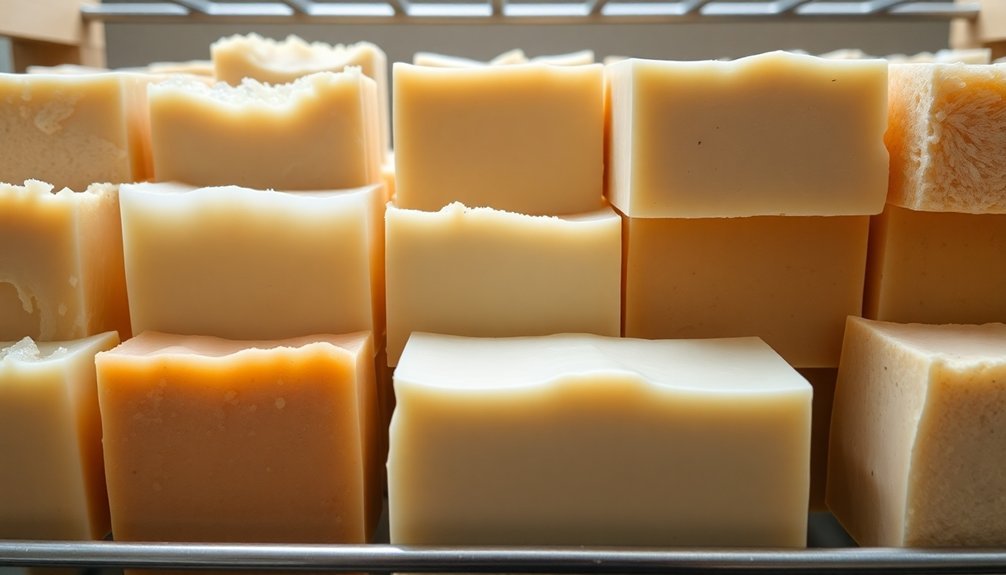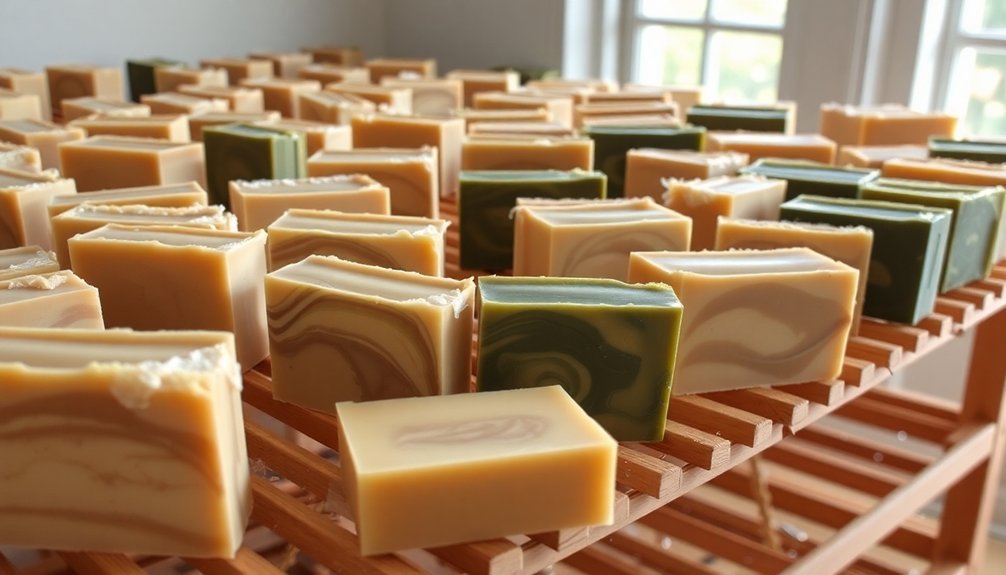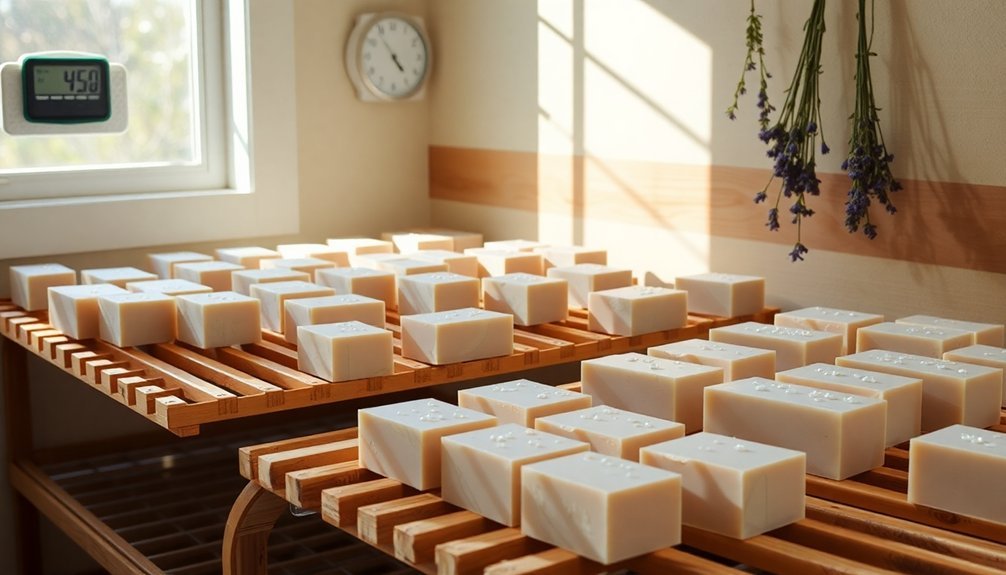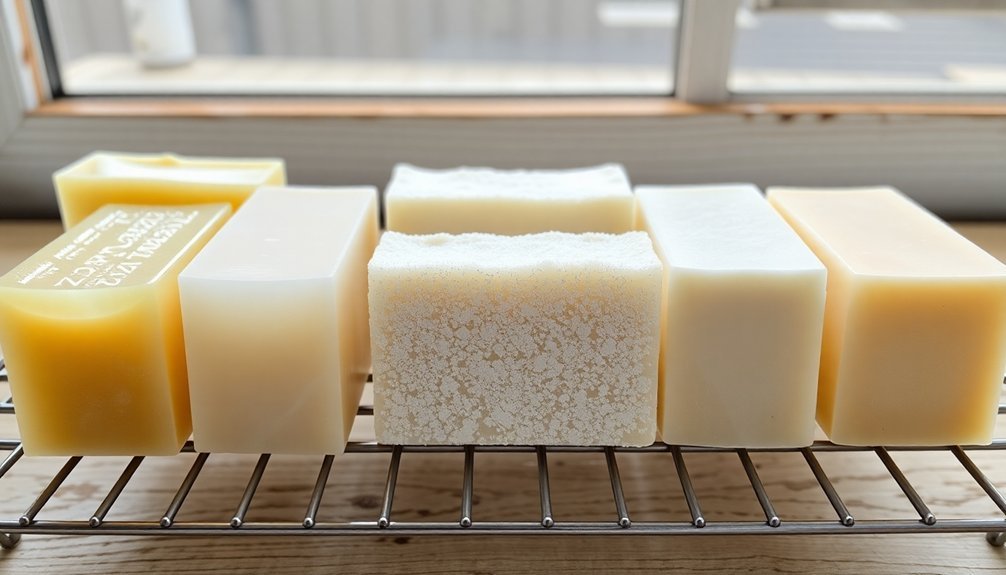Handmade soap bars need proper curing time between batches for essential chemical and physical transformations. During the 4-6 week curing period, excess water evaporates while the lye completely neutralizes, making your soap safe and gentle for skin use. You'll notice your bars become harder, develop a richer lather, and gain enhanced moisturizing properties. Proper curing results in premium quality bars that'll outperform uncured soaps in every way – and there's much more to this fascinating process.
The Science Behind Soap Curing

When you create handmade soap, the curing process plays an essential role in transforming raw soap into a safe, effective product. During soap curing, two critical processes occur simultaneously: excess water evaporates, and lye neutralization completes, guaranteeing your bars are safe for skin use.
You'll notice significant changes as your soap cures over 4-6 weeks. The bars develop increased hardness and superior moisturizing properties while the saponification process finalizes.
During the 4-6 week curing period, soap transforms into its final form, becoming harder and more nourishing through completed saponification.
Environmental factors, particularly humidity, can affect your curing time, so you'll want to store your soap in a well-ventilated area. You'll know your soap has cured properly when it feels firm to the touch and produces a rich, creamy lather.
This patience-requiring process guarantees you'll have high-quality bars that provide prime performance and skin benefits.
Essential Steps in the Curing Process

Successful soap curing requires a methodical approach to achieve the best results. You'll need to guarantee proper conditions for your handmade bars to complete the curing process effectively. When you're soap making, remember that time and environment are vital factors.
| Process Step | Key Requirements |
|---|---|
| Initial Setup | Cool, dry area with good ventilation |
| Spacing | Bars separated on drying racks |
| Environment | Low humidity; use dehumidifier if needed |
| Monitoring | Check hardness and moisture levels weekly |
During the 4-6 week curing time, your bars will undergo important changes as excess water evaporates and lye continues to neutralize. You'll know your soap's ready when it feels hard to touch and produces quality lather. Keep an eye on humidity levels, as they can greatly affect your curing process and final product quality.
Optimal Conditions for Between-Batch Storage

To maintain your handmade soap's quality between batches, proper storage conditions play an essential role in the curing process.
Successful soap curing requires careful attention to storage conditions, ensuring each batch reaches its full potential and optimal quality.
You'll need to store your soap bars in a cool, dry area where temperatures stay between 60°F and 80°F throughout the cure time.
Keep your soaps on wire racks to promote ideal air circulation, which prevents moisture accumulation and helps maintain the bars' quality.
Don't expose them to direct sunlight or high humidity environments, as these conditions can cause sweating and potential mold growth.
For the best storage and ideal conditions during the curing process, select a well-ventilated space that meets these requirements.
Consider using curing cards to track each batch's progress, noting important details like start dates and any changes you observe in your soap bars.
Time Requirements for Different Soap Types

Your cold process soap will need 4-6 weeks to cure properly, while you'll find hot process soaps ready for immediate use after making.
The water-to-oil ratio you choose directly impacts curing time, with water-discounted soaps requiring about 4 weeks and higher water content needing up to 6 weeks for ideal results.
If you're working in a humid environment, you'll need to extend these timeframes, as moisture in the air can greatly slow down the curing process.
Hot Vs Cold Process
When deciding between hot and cold process soap making methods, understanding their distinct curing requirements is crucial.
Cold process soaps need 4-6 weeks of curing time to achieve ideal hardness and guarantee complete saponification, neutralizing all lye. While you can use these bars of soap after two weeks, they won't reach their full potential until properly cured.
Hot process handmade soaps, however, are ready for immediate use due to the cooking step during production.
- Cold process creates smoother, harder bars through natural saponification
- Hot process soaps can be sold right away but may have different textures
- Four to six weeks of curing yields the best quality cold process bars
- Hot process trades ideal hardness for faster production time
When choosing your method, consider whether you prioritize speed or achieving maximum soap quality.
Water-Oil Ratio Effects
Understanding water-to-lye ratios plays a key role in determining your soap's curing timeline. When you're crafting your soap recipe, the water-oil ratio greatly impacts how long your soaps cure. A higher ratio of 2x the lye needed requires 6 weeks, while reducing it to 1.7-1.8x allows saponification to complete in 4 weeks.
| Water Ratio | Curing Time | Properties |
|---|---|---|
| 2x lye | 6 weeks | Softer bars |
| 1.8x lye | 4-5 weeks | Medium bars |
| 1.7x lye | 4 weeks | Firmer bars |
| Hot process | 2-3 weeks | Quick cure |
Your environment matters too. When humidity is high, you'll need extra time to allow water to evaporate. Adding ingredients like castor oil or those high in glycerin may extend curing time since they attract moisture, affecting your final bar's hardness.
Environmental Impact Timeframes
Different soap-making methods result in varying curing timeframes, with environmental conditions playing an essential role in the process.
You'll find that humidity and temperature greatly affect how quickly your soap cures, as these factors directly impact evaporation rates and overall quality development.
- Cold process soaps typically need 4-6 weeks to cure properly, allowing for complete saponification and ideal hardness.
- Hot process soaps cure faster due to added heat during production, making them ready to use almost immediately.
- Using less water in your lye solution (water discount) can reduce curing time to about 4 weeks, compared to 6 weeks with standard ratios.
- High humidity environments will slow down your soap's curing process, while certain ingredients like honey may require extra time to achieve the desired lather quality.
Signs of Properly Cured Soap Bars

To guarantee your handmade soap bars meet quality standards, you'll need to recognize several key indicators of proper curing.
First, properly cured soap should feel hard and firm when you touch it, without any stickiness or excess moisture on the surface. You'll notice the soap color may deepen or transform slightly during the curing process, which is normal and expected.
When testing your soap, look for a rich, creamy lather during use – this is a clear sign of successful curing.
Additionally, you'll detect a pronounced fragrance as the essential oils and fragrance components mature throughout the process. This matured scent profile indicates that your soap has completed its transformation.
These physical characteristics work together to confirm that your handmade soap bars have cured completely and are ready for use.
Maximizing Quality Through Patient Curing
Your patience during the 4-6 week curing process will transform your handmade soap bars into premium products with enhanced performance and durability.
You'll notice significant improvements in lather quality and hardness as moisture gradually evaporates and the soap ages beyond the 30-day mark.
Patience Yields Premium Bars
Although handmade soap becomes safe to use within 24 hours of production, patient curing transforms an ordinary bar into a premium product.
You'll notice the difference when you give your handmade soap the time it needs to reach its full potential. During the 4-6 week curing process, excess moisture evaporates, creating a superior bar that'll enhance your bathing experience.
Here's what you'll gain by practicing patience with your soap:
- Increased soap hardness that guarantees a longer-lasting bar
- Enhanced lather quality, transforming from basic bubbles to rich, fluffy foam
- Fully developed unique scents that create a luxurious experience
- Improved skin compatibility through complete saponification
Your commitment to proper curing time maximizes customer satisfaction and delivers a truly premium product worth waiting for.
Time Enhances Soap Properties
Proper curing time transforms handmade soap from a basic cleansing bar into a luxurious bathing essential. While saponification completes within 24 hours, you'll want to cure your soap for 4-6 weeks to maximize its properties. During this period, moisture evaporation enhances soap longevity and performance.
| Time Period | Changes | Benefits |
|---|---|---|
| 24 Hours | Saponification complete | Safe to handle |
| Week 1-2 | Initial moisture evaporation | Harder bars form |
| Week 3-4 | Continued curing | Rich lather develops |
| Week 5-6 | Final curing stage | Premium quality achieved |
You'll notice humidity temperature affects curing time, so monitor your environment carefully. Your patience will be rewarded with handmade soaps that deliver superior performance, using less water while providing a creamy, moisturizing experience.
Frequently Asked Questions
Why Does Homemade Soap Have to Cure?
You'll need to cure your homemade soap for 4-6 weeks so it's safe to use, free from harsh lye, and properly hardened. It'll also last longer, lather better, and be gentler on your skin.
What Happens if You Don't Let Soap Cure?
If you don't let your soap cure, you'll end up with a harsh, soft bar that contains active lye. It'll dissolve quickly, irritate your skin, and won't lather well, plus it might develop mold.
Can I Use Cold Process Soap Right Away?
While you can technically use cold process soap after 24 hours, you won't get the best experience. It'll be softer, dissolve faster, and lack good lather. Wait 4-6 weeks for ideal quality.
How Much Weight Does Soap Lose During Curing?
You'll notice your handmade soap loses about 10-15% of its initial weight during curing. This happens as excess water evaporates, making your bars harder and longer-lasting. It's a natural part of the process.
In Summary
You'll find that curing your handmade soap bars between batches isn't optional – it's vital for quality and longevity. By letting your bars rest for 4-6 weeks, you're allowing excess water to evaporate, creating a harder, longer-lasting product. Don't rush this vital step. You can test if your soap's properly cured by checking its hardness and ensuring there's no moisture trapped inside.





Leave a Reply